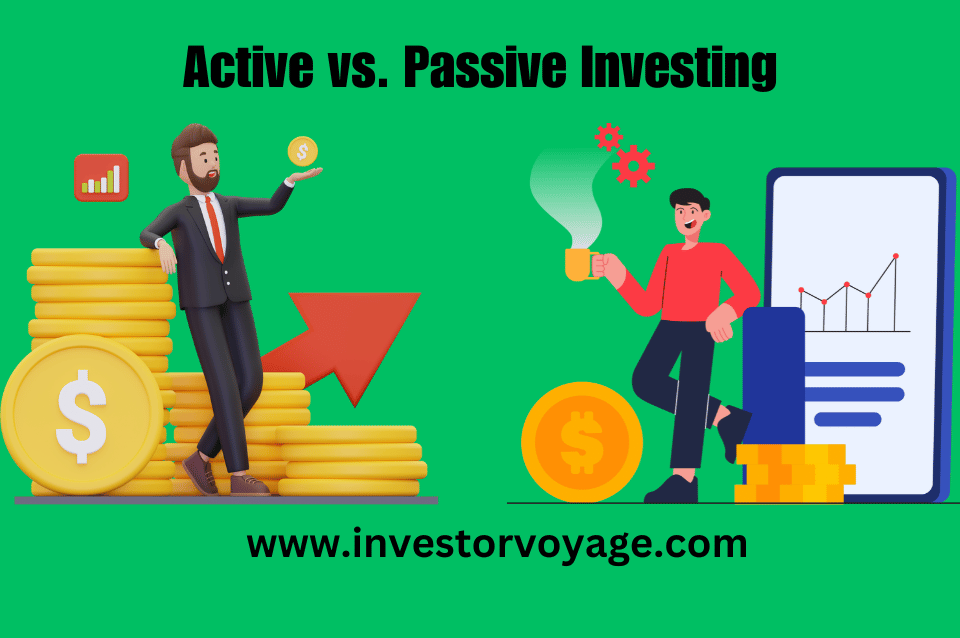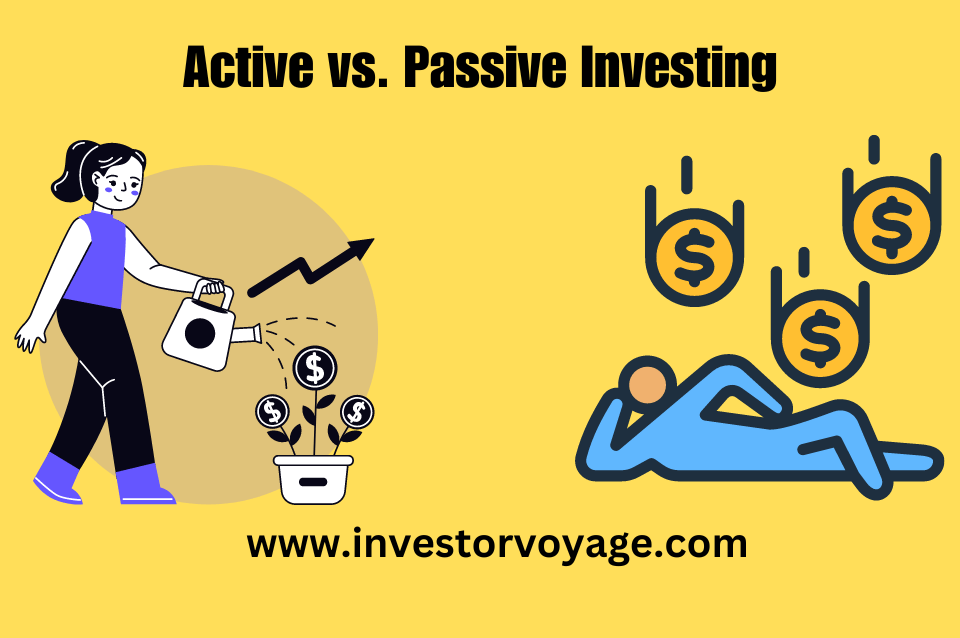When it comes to investing, one of the most critical decisions you’ll face is whether to adopt an active or passive investment plan. These two approaches to investment management reflect fundamentally distinct mindsets and practices. Active investing entails often purchasing and selling assets in order to beat the market, while passive investing focus on long-term growth by duplicating a market index’s performance.
In this article, we’ll look at the benefits and drawbacks of active and passive investing, the considerations to consider when deciding on a plan, and which technique may be most suited to your financial objectives. Whether you are a seasoned investor or just getting started, knowing these tactics is critical to your market success.
What is Active Investing?
Understand Active Investing
Active investing is a method in which individuals or fund managers try to beat the market by making targeted purchase and sell choices. This hands-on approach entails constantly monitoring the market, considering financial data, and making timely choices based on market trends, corporate performance, and macroeconomic circumstances. The aim is to outperform a certain benchmark, such as the S&P 500.
Techniques for Active Investing
Active investors use a variety of methods to identify opportunities, including:
- Fundamental analysis: Assessing a company’s financial accounts, management, and competitive advantages.
- Technical analysis: Price changes, trading volumes, and historical trends are all being analysed.
- Market Timing: Attempting to foresee market trends in order to buy low and sell high.
Advantages of Active Investment
- Potential for higher returns: Active investors seek to outperform the market, which can result in larger returns.
- Flexibility: Investors can respond swiftly to changing market conditions.
- Customised Portfolios: Active investing provides for customised solutions based on individual financial objectives.
Disadvantages of Active Investing
- More Costs: Usually involving greater fees due to frequent trading and research expenses, active management
- Growing Risk: Higher risk accompanies the possibility for better rewards, especially in cases of off-target market timing.
- Time-Intensive: Research and portfolio management in active investing call for a lot of time.
Passive investing: what exactly is it?
Dealing with Passive Investing
Using a diversified portfolio of assets, passive investing is a long-term approach whereby one may replicate the performance of a given market index, say the S&P 500. Passive investing, unlike active investing, emphasises preserving a consistent, long-term growth path and calls for less trading.
Passive Investment Strategies
Usually investing in index funds or exchange-traded funds (ETFs), passive investors match the performance of an index. The theory is to profit from the market’s overall upward tendency over time since it is certain that patient investors would be rewarded by it finally.
Advantages of Passive Investing
- Lower Costs: Passive investing is cost-effective due to lower management fees and reduced trading costs.
- Reduced Risk: By diversifying across an entire index, passive investors spread their risk across many assets.
- Simplicity: Passive investing requires less time and effort, making it an attractive option for long-term investors.
Disadvantages of Passive Investing
- Limited Upside Potential: Passive investors only achieve market returns, which may not be as high as those achieved through successful active investing.
- Lack of Flexibility: Passive investors cannot easily take advantage of short-term market opportunities.
- Tracking Errors: There can be slight discrepancies between the index and the fund’s performance due to tracking errors.
Main Variations between Active and Passive Investing
Investment Approach
Active and passive investing vary fundamentally in their investment philosophies. Based on the idea that study, analysis, and market timing allow investors to get returns greater than the market average, active investing is Passive investment, on the other hand, is predicated on the conviction that markets are typically efficient and that trying to regularly beat them is improbable.
Taxes and Fees
Cost is one of the two techniques’ most important distinctions. Because active investing requires constant research, portfolio changes, and frequent trading, costs usually are more. Conversely, as passive investment calls for less trading and administration, it results in cheaper expenses.
Performance Goals
Higher than average returns are the goal of active investors, hence, should they be successful, significant profits may follow. This method, nonetheless, also runs the danger of underperformance. Although this strategy doesn’t provide the chance of outperforming the market, passive investors want to equal the performance of the market, which has historically usually grown over the long run.
Time and participation
Investors in active investing must continually watch the market, evaluate data, and make judgements, thereby requiring a significant time and effort. Because passive investing uses a buy-and-hold approach with little involvement, it takes much less time.
How to Choose Between Active and Passive Investing?
Review Your Objectives Regarding Finance
Choosing between active and passive investing should mostly rely on your financial objectives. Active investing may be appropriate if your objective is notable increase and you have a high risk tolerance. Passive investment could be a better match, on the other hand, if you want consistent, long-term gain with less risk.
Think about your risk tolerance.
Because of the possibility for market volatility and the challenge of regularly exceeding the market, active investing carries more risk. Active investing may be suitable if you have a greater risk tolerance and are at ease with the prospect of temporary losses in search of long-term benefits. Passive investing can better fit your risk tolerance if you would like a more cautious strategy.
Time Requirement
Think about the time you could commit to handling your finances. Those who can dedicate a lot of time to their investments would find active investing better suited as it calls for constant study and portfolio management. Those who want a more automatic, long-term plan might find passive investing—with its hands-off approach—perfect.
Case Studies: Actual Active and Passive Investing Examples
Case Study 1: Successful Active Investing Under Warren Buffett
One of the most successful investors of all times, Warren Buffett is a shining illustration of the possible advantages of active investment. By carefully choosing undervalued firms with good foundations, Buffett has often exceeded the market via his firm, Berkshire Hathaway. His achievement shows the possible benefits of well done active investment.
Case Study 2: Passive Investing Strategy Success of Vanguard
Pioneer of passive investing, Vanguard provides some of the most often used index funds and ETFs accessible today. For long-term investors, the Vanguard 500 Index Fund—which follows the S&P 500—has given consistent returns. For people who want a low-cost, low-risk method of increasing their money, this case study shows how well passive investing works.
Data and Statistics: Comparing Active and Passive Investing
Historical Action
Over the long run, studies have repeatedly found that passive investment generally beats active investing. Over a ten-year period ending in 2022, the S&P Dow Jones Indices show that almost eighty percent of actively managed funds underperformed their benchmarks. This data implies that although active investing might offer better short-term returns, it is difficult to regularly outperform the market over the long run.
Economic Comparison
Passive investment clearly offers a cost benefit. Comparatively to approximately 0.13% for passively managed index funds, Morningstar notes that the average expense ratio for actively managed funds is around 0.67%. For passive investors, these reduced expenses over time might produce better net returns.
Risk and Variability
Usually linked with more volatility owing to frequent trading and possible market timing mistakes is active investment. By comparison, passive investment offers more consistent returns over time and usually less volatility. Investors that are risk-averse may find especially enticing this lower volatility.
External Resources for Further Reading
For Active Investors
- Morningstar: Offers in-depth research, analysis, and tools for active investors.
- Seeking Alpha: A platform for investment ideas, market analysis, and stock picks.
- Yahoo Finance: Provides real-time stock quotes, financial news, and data analysis.
For Passive Investors
- Vanguard: Known for its low-cost index funds and ETFs, Vanguard is a leader in passive investing.
- Fidelity: Offers a variety of index funds and tools for passive investors.
- Charles Schwab: Provides a range of low-cost ETFs and educational resources for passive investors.
Finally
Your personal financial objectives, risk tolerance, and available time to dedicate to managing your assets will determine whether active or passive investing best suits you. Though it carries more risk and expenses, active investing has the possibility for better returns. Though less expensive and less dangerous, passive investment could not provide the same chance for outsized rewards. Understanding the variations among these approaches and matching them with your own goals will help you to make a wise choice that will guide you toward financial success.
FAQ: Common Questions About Active vs. Passive Investing
1. What are the main differences between active and passive investing?
Active investing involves a hands-on approach where investors or fund managers make specific buy or sell decisions to outperform the market. Passive investing, on the other hand, focuses on replicating the performance of a market index and involves minimal trading.
2. Which investing strategy is better for long-term growth?
Passive investing is generally considered better for long-term growth due to its lower costs, reduced risk, and the tendency of markets to grow over time. However, active investing can provide higher returns in the short term if done successfully.
3. Can I combine both active and passive investing strategies?
Yes, many investors choose a hybrid approach, combining active and passive strategies to diversify their portfolios. This allows them to benefit from the potential gains of active investing while also enjoying the stability and lower costs of passive investing.
4. What are the risks associated with active investing?
Active investing involves higher risks, including the potential for underperformance, increased volatility, and higher costs due to frequent trading. It also requires significant time and expertise to be successful.
5. Why are passive investments generally cheaper than active investments?
Passive investments are cheaper because they involve minimal trading and do not require the same level of research and management as active investments. This results in lower management fees and overall costs for investors.
Do you feel prepared to go to the next stage of your investment journey? The most important thing is to keep yourself updated and to examine your plan on a regular basis, regardless of whether you choose active or passive investment. The comments section below is where you can share your ideas on active versus passive investing. Alternatively, you may read some of our other articles to gain other insights on how to reach your financial objectives.
I appreciate you taking the time to read! We really hope that this post has offered information that is helpful in understanding active and passive investment. Be sure to add our website to your bookmarks and check it out on a regular basis for further professional guidance, suggestions, and methods that will assist you in navigating the world of money and investing.



